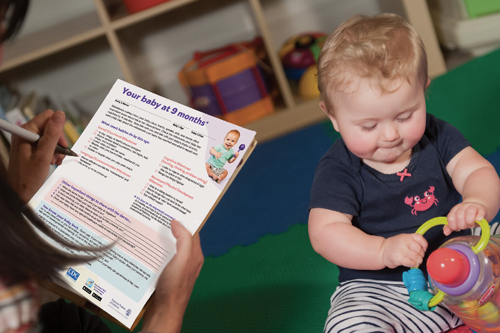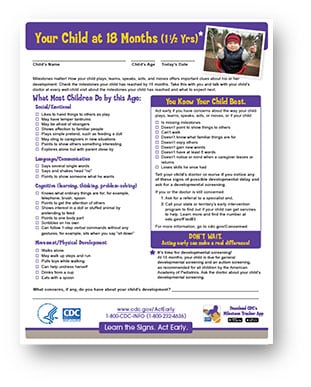Component 2 – Administering Milestone Checklists
Developmental Milestone Checklists

Age-appropriate milestone checklists are an essential part of the WIC Developmental Milestone Checklist Program. These checklists include the skills that most children develop by that age. They were developed by the Centers for Disease Control and Prevention’s Learn the Signs. Act Early. Program, with milestones adapted from the American Academy of Pediatrics’ Caring for Your Baby and Young Child and Bright Futures publications. They use parent-friendly language and helpful examples and have been well-received by parents of young children across the country.
The WIC Developmental Milestone Checklist Program requires that parents are offered the opportunity to complete a developmental milestone checklist appropriate for the age of their child during WIC certification and mid-certification visits. In addition, checklists may be used any time a parent or WIC staff has a concern about a child’s development.
Checklists can be printed by the state, agency, or clinic and customized with your logo and contact information, specific referral guidance, and local resources for families. Including local contact information for referrals and services is very helpful to families. Request customizable files from ActEarly@cdc.gov.
Checklist Content
Ten checklists are available from ages 2 months to 5 years (2, 4, 6, 9, 12, and 18 months and 2, 3, 4, and 5 years). All checklists are structured in the same way.
The front of the checklist includes
- The checklist age at the top
- A space to enter the child’s name, age, and the date of visit
- A brief description of developmental milestones
- A list of milestones under the heading “What Most Babies/Children Do at this Age,” organized by categories of development: social/emotional, language/communication, cognitive, and movement/physical development; this section is used to monitor the child’s progress and to educate parents about typical abilities at that age
- On the right, in a purple box, is a list of warning signs—indicators of possible concern
- At the bottom of the purple box is a recommendation to talk with the doctor if there are signs of possible developmental delay. This area can be customized to include contact information for agencies in your area or state that provide screening, further assessment, and other services for young children
- At the bottom of the page is a place for parents to write in any additional concerns they might have about the child’s development
The back of the checklist includes sections that the state WIC agency must customize to provide parents the best referral guidance and program contact information for their state.
The section entitled “Your Next Steps” includes
- Next steps for all parents to take, including sharing the checklist with the child’s doctor and continuing to track milestones between WIC visits
- Steps for parents to take if the child is missing milestones or there are other potential developmental concerns
This section serves as the “referral” and must be customized with appropriate contact information.
A note with helpful background information for the child’s doctor (or whomever the parent will be referred to for developmental screening) appears in the light purple box near the bottom.
This section can also be customized when the referral is being made to an entity other than the child’s doctor.






















.png)











No hay comentarios:
Publicar un comentario